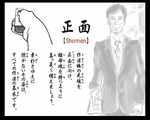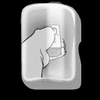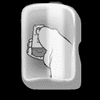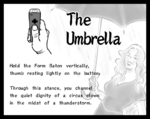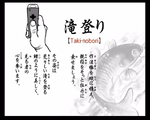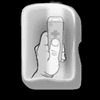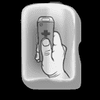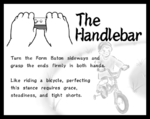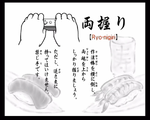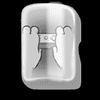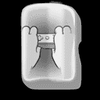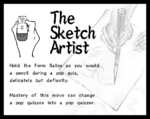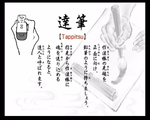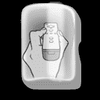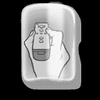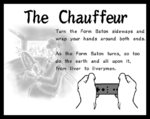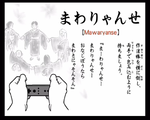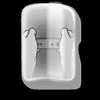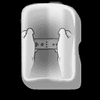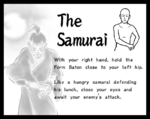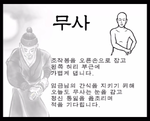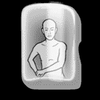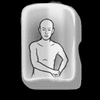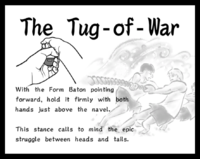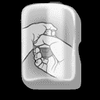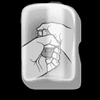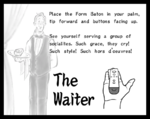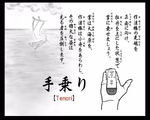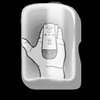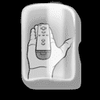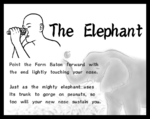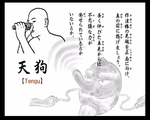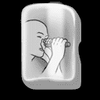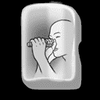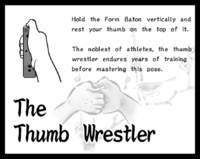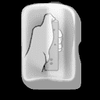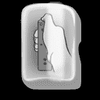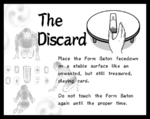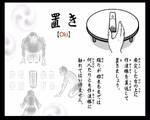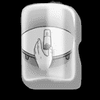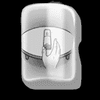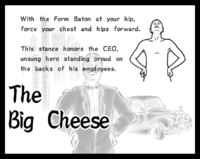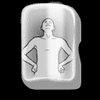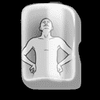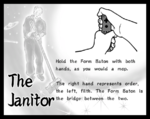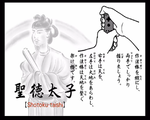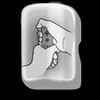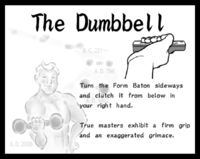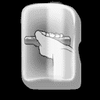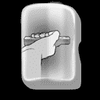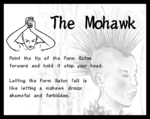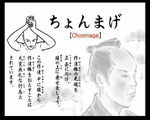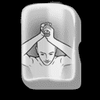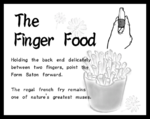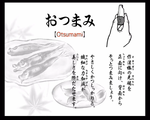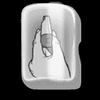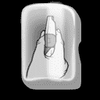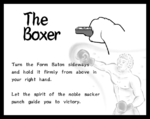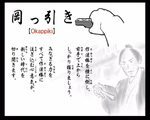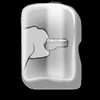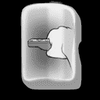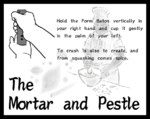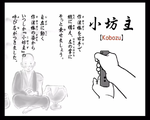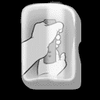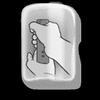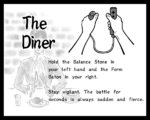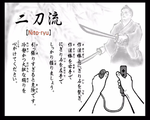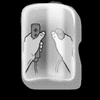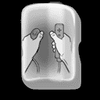Form Baton
The Form Baton is a major object featured in WarioWare: Smooth Moves. It is an old Wii Remote used as the controls for the entire game, with all in-game instructions using the term "Form Baton" to refer to the player's Wii Remote. The Form Baton also has a Nunchuk counterpart, known as the Balance Stone, which is shown in Orbulon's set of microgames. During the events of the game, Wario stumbles upon the Form Baton after crash-landing into the Temple of Form. He soon finds out that how one uses it depends on the way one holds it, in reference to how the player must hold the Form Baton in different positions to play the different types of microgames.
Forms[edit]
Forms, as the name implies, are the modes of holding the ![]() Form Baton (Wii Remote) in WarioWare: Smooth Moves. The forms are introduced by the form explanation, which acts as an often comedic tutorial of how to use each form. Each form is used for certain microgames in the game. Below is a list of forms (and compatible microgames) in order of their appearance (microgames in an italic font last twice as long).
Form Baton (Wii Remote) in WarioWare: Smooth Moves. The forms are introduced by the form explanation, which acts as an often comedic tutorial of how to use each form. Each form is used for certain microgames in the game. Below is a list of forms (and compatible microgames) in order of their appearance (microgames in an italic font last twice as long).
The Remote Control[edit]
In-game text[edit]
- Description: "This is the most basic and popular of all the forms."
- Form explanation (English version):
Hold the Form Baton straight with the tip pointing forward.
This simple stance reflects one of life's fiercest--and greatest--sports: channel surfing.
- Form explanation (Japanese version):
- Japanese script:
作法棒の先端を正面に向け、離母魂を持つように真っ直ぐ構えましょう。
素朴さゆえに隙がないその姿は、すべての作法の基本です。
- Romanization:
Sahō Bō no sentan o shōmen ni muke, rimokon o motsu yō ni massugu kamaemashō.
Soboku sa yue ni suki ga nai sono sugata wa, subete no sahō no kihon desu.
- Translation:
With the tip of the Form Baton pointing forward, hold it ready just like a remote control.
Due to its simplicity, this effortless form is the basis for all modes.
- Form explanation (Spanish version):
Sosténgase la watuta recta y apuntando hacia delante.
Simple forma inspirada en uno de los ejercicios de sofá más edificantes que existen: el zapeo.
- Translation:
Hold the Form Baton straight and pointing forward.
Simple shape inspired by one of the most uplifting couch exercises out there: zapping.
- Form explanation (French version):
Tiens le Bâton de style à l'horizontale, le pointeur orienté vers l'avant.
Cette position illustre le sport le plus pratiqué de nos jours: le zapping!
- Translation:
Hold the Form Baton horizontally with the pointer pointing forward.
This position illustrates the most practiced sport these days: zapping!
- Form explanation (Italian version):
Tieni la bacchetta multiforme dritta, puntandola in avanti.
Questa semplice postura imita uno degli sport più belli e aggresivi che si conoscano: lo zapping!
- Translation:
Hold the Form Baton straight, pointing it forward.
This simple posture imitates one of the most beautiful and aggressive sports known: zapping!
- Form explanation (German version):
Halte den Formenstab waagerecht mit dem Zeiger nach vorn.
Diese einfache Haltung stellt eine der härtesten, aber schönsten, Sportaten dar: das Zappen.
- Translation:
Hold the Form Baton horizontally with the pointer forward.
This simple pose represents one of the toughest, but most beautiful, sports: zapping.
- Form explanation (Korean version):
- Korean script:
조작봉의 끝이 정면을 향한 상태에서 잡습니다.
소박하면서도 빈틈이 없는그 모습이야말로 모든 조작의 기본이라 할 수 있습니다.
- Romanization:
Jojagbong-ui kkeut-i jeongmyeon-eul hyanghan sangtaeeseo jabseubnida.
Sobaghamyeonseodo binteum-i eobsneungeu moseub-iyamallo modeun jojag-uigibon-ila hal su issseubnida.
- Translation:
Hold the Form Baton with the tip facing forward.
Its simple yet flawless appearance is the basis for all operations.
Microgames and hosts[edit]
Names in other languages[edit]
| Language | Name | Meaning | Notes |
|---|---|---|---|
| Japanese | 正面[1] Shōmen |
Front | |
| Dutch | The Remote Control[2] | - | |
| French | La télécommande[?] | The remote control | |
| German | Die Fernbedienung[3] | The Remote Control | |
| Italian | Il telecomando[4] | The remote control | |
| Korean | 리모컨[?] Rimokeon |
The Remote Control | |
| Spanish (Latin America) | El Control Remoto Wii[?] | The Wii Remote Control | |
| Spanish (Europe) | El zapeador[5] | The remote control (lit. "The zapper") |
Notes[edit]
- None of Tiny Wario's microgames use the Remote Control. Instead, Wario's microgames appear in Tiny Wario's stage and start at level 2.
The Umbrella[edit]
In-game text[edit]
- Description: "After the Remote Control, this is the second-most-popular form."
- Form explanation (English version):
Hold the Form Baton vertically, thumb resting lightly on the button.
Through this stance, you channel the quiet dignity of a circus clown in the midst of a thunderstorm.
- Form explanation (Japanese version):
- Japanese script:
作法棒を縦に構え、親指をそっと牡丹に乗せましょう。
その姿は、荒々しい滝を登る鯉のように美しく、見る者の心を奪います。
- Romanization:
Sahō Bō o tate ni kamae, oyayubi o sotto botan ni nosemashō.
Sono sugata wa, araarashii taki o noboru koi no yō ni utsukushiku, miru mono no kokoro o ubaimasu.
- Translation:
With the Form Baton in vertical position, place your thumb gently on the button.
This form, beautiful as the koi that climbs violent waterfalls, steals the hearts of those who see it.
- Form explanation (Spanish version):
Sosténgase la watuta en vertical y apóyese el pulgar suavemente sobre el botón.
Esta forma sintetiza la sobria dignidad de un payaso circense en medio de un chaparrón de los que hacen época.
- Translation:
Hold the Form Baton upright and rest your thumb lightly on the button.
This form synthesizes the sober dignity of a circus clown in the midst of a downpour of those who make an era.
- Form explanation (Korean version):
조작봉을 세로로 세워 잡고 엄지손가락을 버튼 위에 살짝 올려놓습니다.
장대비도 두려워하지 않는 우아하고 당당한 자태가 보는 이의 마음을 사로잡습니다.
- Translation:
Hold the Form Baton vertically and place your thumb slightly over the button.
Its graceful, regal stance, unafraid of the heavy rain, captivates the viewer.
Microgames and hosts[edit]
| Microgame | Host(s) | Note | Microgame | Host(s) | Note |
|---|---|---|---|---|---|
Welcome Committee |
Mona |
N/A | Fan Boy |
Mona |
N/A |
Shakedown |
Mona |
N/A | Swat Team |
Mona |
N/A |
Runner's High |
Mona |
N/A | Dough Boy |
Mona |
N/A |
Hand Me Down |
Mona |
N/A | Wet Your Whistle |
Mona |
N/A |
Boss: Toilet Training |
Mona |
N/A | Undercover Agent |
Ashley & Red |
Levels 1 & 2 |
Shady Characters |
Ashley & Red |
Level 2 | Ringmaster |
Ashley & Red |
N/A |
When in Rome… |
Dribble & Spitz |
Level 1 | Femme Brûlée |
Dribble & Spitz |
N/A |
Wiipeat After Me! |
9-Volt & 18-Volt |
Level 3 | Super Mario Brothers |
9-Volt & 18-Volt |
N/A |
Punch-Out!! |
9-Volt & 18-Volt |
N/A | He Who Smelt It... |
Tiny Wario |
N/A |
Boss: Wario Dance Company |
Tiny Wario |
N/A |
Names in other languages[edit]
| Language | Name | Meaning | Notes |
|---|---|---|---|
| Japanese | 滝登り[6] Taki-nobori |
Swimming up a waterfall | |
| Dutch | The Umbrella[2] | - | |
| French | Le parapluie[?] | The umbrella | |
| German | Der Regenschirm[3] | The Umbrella | |
| Italian | L'ombrello[4] | The umbrella | |
| Korean | 우산[?] Usan |
The Umbrella | |
| Spanish | El paraguas[5] | The umbrella |
The Handlebar[edit]
In-game text[edit]
- Description: "This is the most balanced form. Most Handlebar games require quick movements."
- Form explanation (English version):
Turn the Form Baton sideways and grasp the ends firmly in both hands.
Like riding a bicycle, perfecting this stance requires grace, steadiness, and tight shorts.
- Form explanation (Japanese version):
- Japanese script:
作法棒を横に倒し、両端を上からしっかり握りましょう。
ただし、逆さまに持ってはいけません。禁じ手です。
- Romanization:
Sahō Bō o yoko ni taoshi, ryōhashi o ue kara shikkari nigirimashō.
Tadashi, sakasama ni motte wa ikemasen. Kinjite desu.
- Translation:
Turn the Form Baton horizontally and grasp both ends firmly from above.
You must not, however, hold it upside down: that is a forbidden move.
- Form explanation (Spanish version):
Póngase la watuta de lado y agárrese bien con las dos manos por los extremos.
Como el montar en bicicleta, el dominio de esta forma exige agilidad, equilibrio y pantalones ajustados.
- Translation:
Put the Form Baton on its side and hold on tight with both hands by the ends. Like riding a bicycle, mastering this form requires agility, balance, and tight pants.
- Form explanation (Korean version):
조작봉을 옆으로 눕히고 양쪽 끝을 두 손으로 단단히 잡습니다.
보조바퀴를 달고도 두려웠던 그 시절... 완벽한 자세를 위해 필요한 것은 균형감, 우아함, 그리고 헬멧.
- Translation:
Lay the Form Baton on its side and grip both ends firmly with both hands.
The days when you were afraid to ride, even with training wheels... All you need for perfect form is balance, elegance, and a helmet.
Microgames and hosts[edit]
| Microgame | Host(s) | Note | Microgame | Host(s) | Note |
|---|---|---|---|---|---|
Keep Your Guy on the Ball |
Mona |
N/A | Carrot Away |
Mona |
N/A |
Fired Up |
Mona |
N/A | Come to Poppa |
Mona |
N/A |
Closing Time |
Mona |
N/A | Universal Marionette |
Mona |
N/A |
Tearful Reunion |
Mona |
N/A | Super Nostalgic Entertainment System |
9-Volt & 18-Volt |
N/A |
Party Crasher |
Tiny Wario |
N/A | Climate Control |
Tiny Wario |
N/A |
Names in other languages[edit]
| Language | Name | Meaning | Notes |
|---|---|---|---|
| Japanese | 両握り[7] Ryō-nigiri |
"Gripping with both hands", also includes nigiri ("nigirizushi") | |
| French | Le guidon[?] | The handlebar | |
| German | Die Stange[?] | The Handlebar | |
| Italian | Il manubrio[?] | The handlebar | |
| Korean | 자전거[?] Jajeongeo |
The Bicycle | |
| Spanish | El manillar[?] | The handlebar |
The Sketch Artist[edit]
In-game text[edit]
- Description: "This form is best suited for movements requiring precision. Use your dominant hand to perform this form."
- Form explanation (English version):
Hold the Form Baton as you would a pencil during a pop quiz, delicately but defiantly.
Mastery of this move can change a pop quizzee into a pop quizzer.
- Form explanation (Japanese version):
- Japanese script:
作法棒の先端を正面に向け、鉛筆のように持ちましょう。
指先から作法棒に魂を送り込めるようになると、達人と呼ばれます。
- Romanization:
Sahō Bō no sentan o shōmen ni muke, enpitsu no yō ni mochimashō.
Yubisaki kara Sahō Bō ni tamashii o okurikomeru yō ni naru to, tatsujin to yobaremasu.
- Translation:
With the tip of the Form Baton pointing forward, hold it like a pencil.
When you are able to send your spirit from your fingertips to the Form Baton, then you will be called master.
- Form explanation (Spanish version):
Sosténgase la watuta como si del mejor pincel de pelo de camello se tratara.
El dibujo a mano alzada con tinta invisible es un pasatiempo económico practicado por genios de todas las épocas.
- Translation:
Hold the Form Baton as if it were the best camel's hair brush.
Freehand drawing with invisible ink is an inexpensive hobby practiced by geniuses of all ages.
- Form explanation (Korean version):
조작봉의 끝이 정면을 향한 상태에서 연필을 잡듯이 잡습니다.
손끝에서 뿜어 나오는 혼을 실으면 마치 한 폭의 그림과도 같은 예술적인 자세가 완성됩니다.
- Translation:
Hold the Form Baton as you would a pencil, with the tip facing forward.
With soul radiating from your fingertips, your posture is a work of art.
Microgames and hosts[edit]
| Microgame | Host(s) | Note | Microgame | Host(s) | Note |
|---|---|---|---|---|---|
On the Edge |
Kat & Ana |
N/A | Serve Already! |
Kat & Ana |
Level 3 |
Paper Trail |
Kat & Ana |
N/A | Object D'Art |
Kat & Ana |
N/A |
Writer's Block |
Kat & Ana |
N/A | Teeth Polithe |
Kat & Ana |
N/A |
Cookie Rookie |
Kat & Ana |
N/A | Saving Face |
Kat & Ana |
N/A |
Stick It Through 'Em! |
Kat & Ana |
N/A | Budget Dentistry |
Kat & Ana |
N/A |
Brain Age |
9-Volt & 18-Volt |
N/A | Bedside Manners |
Tiny Wario |
N/A |
Dead Ringer |
Tiny Wario |
N/A |
Names in other languages[edit]
| Language | Name | Meaning | Notes |
|---|---|---|---|
| Japanese | 達筆[8] Tappitsu |
Vigorous Writing | |
| Dutch | The Sketch Artist[2] | - | |
| French | Le dessinateur[?] | The sketch artist | |
| German | Der Zeichner[3] | The Sketch Artist | |
| Italian | Il disegnatore[4] | The sketch artist | |
| Korean | 화가[?] Hwaga |
The Painter | |
| Spanish | El dibujante[5] | The sketch artist |
The Chauffeur[edit]
In-game text[edit]
- Description: "This form is best suited for gyrating movements."
- Form explanation (English):
Turn the Form Baton sideways and wrap your hands around both ends.
As the Form Baton turns, so too do the earth and all upon it, from liver to liverymen.
- Form explanation (Japanese version):
- Japanese script:
作法棒を横に倒し、両手で包み込むように持ちましょう。
『まーわりゃんせーまわりゃんせーおなじぼうならまわさにゃそんそん』
- Romanization:
Sahō Bō o yoko ni taoshi, ryōte de tsutsumikomu yō ni mochimashō.
"Māwaryansē mawaryansē onaji bō nara mawasanya son son"
Translation:
Turn the Form Baton horizontally and hold it with both hands like you are wrapping it.
"Turn it, please, turn it. As they are bars alike, why not to turn it?"
- Form explanation (Spanish version):
Póngase la watuta de lado y agárrese por los extremos.
Los movimientos de la watuta alterarán hasta las órbitas de los astros si se coge de esta forma.
- Translation:
Put the Form Baton on its side and hold on to the ends.
The movements of the Form Baton will even alter the orbits of the stars if it is held in this way.
- Form explanation (Korean version):
조작봉을 옆으로 눕히고 양쪽 끝을 두 손으로 감싸듯이 잡습니다.
조작봉의 회전에 따라 지구와 지구상의 모든 생물체가 움직이는 놀라운 힘이 느껴집니다.
- Translation:
Lay the Form Baton on its side and hold it with your hands wrapped around both ends.
You can feel the incredible power that moves the Earth and all life on it as the Form Baton rotates.
Microgames and hosts[edit]
| Microgame | Host(s) | Note | Microgame | Host(s) | Note |
|---|---|---|---|---|---|
Extreme Patty-Cake |
Kat & Ana |
N/A | BYOM |
Kat & Ana |
N/A |
A Moment of Reflection |
Kat & Ana |
N/A | Fitting In |
Kat & Ana |
N/A |
A-maze-ing |
Kat & Ana |
N/A | Code Dependency |
Kat & Ana |
N/A |
Boss: Driver's Ed |
Kat & Ana |
N/A | WarioWare: Twisted! |
9-Volt & 18-Volt |
N/A |
Sifty Character |
9-Volt & 18-Volt |
N/A | Boss: Star Fox |
9-Volt & 18-Volt |
N/A |
Wario's Pinheads |
Tiny Wario |
N/A | Chop Shop |
Tiny Wario |
N/A |
Names in other languages[edit]
| Language | Name | Meaning | Notes |
|---|---|---|---|
| Japanese | まわりゃんせ[9] Mawaryanse |
Making the Rounds | |
| French | Le chauffeur[?] | The chauffeur | |
| German | Das Lenkrad[?] | The Steering Wheel | |
| Italian | L'autista[?] | The chauffeur | |
| Korean | 운전기사[?] Unjeongisa |
The Chauffeur | |
| Spanish | El chófer[?] | The chauffeur |
Notes[edit]
- The Japanese form explanation includes a verse based on Awa Yoshikono, a song associated with the Awa Odori Festival in Japan.
The Samurai[edit]
In-game text[edit]
- Description: "You can feel the spirit of the samurai in this form. It's said that your breathing affects the outcome."
- Form explanation (English version):
With your right/left hand, hold the Form Baton close to your left/right hip.
Like a hungry samurai defending his lunch, close your eyes and await your enemy's attack.
- Form explanation (Japanese version):
- Japanese script:
作法棒を(右手/左手)で握り、(左/右)の腰のあたりに当てて構えましょう。
目を閉じゆっくり息を整え、襲いくる敵を持つのです。
- Romanization:
Sahō Bō o migite/hidarite de nigiri, hidari/migi no koshi no atari ni atete kamaemashō.
Me o tojiyukkuri iki o totonoe, osoikuru teki o motsu no desu.
- Translation:
Grasp the Form Baton with your right/left hand and hold it against your left/right hip.
Close your eyes and breathe slowly to survive the opponent’s attack.
- Form explanation (Spanish version):
Sujétese la watuta con la mano derecha/izquierda y sosténgase pegada a la cadera izquierda/derecha.
Cual samurái hambriento defendiendo su almuerzo, uno debe concentrarse y aguardar el ataque de su adversario.
- Translation:
Hold the Form Baton in your right/left hand and keep it close to your left/right hip. Like a hungry samurai defending his lunch, one must concentrate and await the attack of his adversary.
- Form explanation (Korean version):
조작봉을 오른손/왼손으로 잡고 왼쪽/오른쪽 허리 부근에 가볍게 댑니다.
임금님의 간식을 지키기 위해 오늘도 무사는 눈을 감고 정신 통일을 읊조리며 적을 기다립니다.
- Translation:
Hold the Form Baton in your right/left hand and place it lightly on your left/right waist.
To protect the king's treat, the warrior closes his eyes, recites a mental unification mantra, and waits for the enemy.
Microgames and hosts[edit]
| Microgame | Host(s) | Note | Microgame | Host(s) | Note |
|---|---|---|---|---|---|
Cutting Edge |
Kat & Ana |
N/A | Frequent Flyer |
Kat & Ana |
N/A |
Simon Says |
Kat & Ana |
N/A | Mall Tour |
Kat & Ana |
N/A |
Rude Awakening |
Tiny Wario |
N/A |
Names in other languages[edit]
| Language | Name | Meaning | Notes |
|---|---|---|---|
| Japanese | 下段の構え[?] Gedan no kamae |
Low position stance | |
| French | Le samouraï[?] | The samurai | |
| German | Der Samurai[?] | The Samurai | |
| Italian | Il samurai[?] | The samurai | |
| Korean | 무사[10] Musa |
The Warrior | |
| Spanish | El samurái[?] | The samurai |
Notes[edit]
- The Korean version has a unique design for this form. The samurai in the artwork is replaced by a Joseon-style warrior, due to South Korean restrictions on Japanese cultural imports at that time.
The Tug-of-War[edit]
In-game text[edit]
- Description: "This form has been taught from generation to generation. Lately, the tend has been to bring the hands closer together."
- Form explanation (English version):
With the Form Baton pointing forward, hold it firmly with both hands just above the navel.
This stance calls to mind the epic struggle between heads and tails.
- Form explanation (Japanese version):
- Japanese script:
作法棒の先端を正面に向け、両手でしっかり握りましょう。
臍の上あたりで構えるのが通です。
- Romanization:
Sahō Bō no sentan o shōmen ni muke, ryōte de shikkari nigirimashō.
Heso no ue atari de kamaeru no ga tsū desu.
- Translation:
With the Form Baton pointing forward, hold it firmly with both hands.
Experts hold it just above the navel.
- Form explanation (Spanish version):
Sujétese bien la watuta por encima del ombligo con las dos manos y apúntese hacia delante.
Ojo: Esta forma no debe confundirse con el harakiri.
- Translation:
Hold the Form Baton above the navel with both hands and point forward.
Note: This form should not be confused with the harakiri.
- Form explanation (Korean version):
조작봉의 끝이 정면을 향한 상태에서 양손으로 꽉 잡습니다.
조작봉이 나를 잡아당기는지, 내가 조작봉을 잡아당기는지 알 수 없는 바로 그 순간이 이 자세의 묘미입니다.
- Translation:
Hold the Form Baton tightly with both hands, with the ends pointing forward.
The charm of this position is the moment that you don't know if the Form Baton is pulling you or if you are pulling the Form Baton.
Microgames and hosts[edit]
| Microgame | Host(s) | Note | Microgame | Host(s) | Note |
|---|---|---|---|---|---|
Plane and Simple |
Young Cricket & Master Mantis |
N/A | Logged In |
Young Cricket & Master Mantis |
N/A |
Anchor Man |
Young Cricket & Master Mantis |
N/A | All Wound Up |
Young Cricket & Master Mantis |
N/A |
Sweeps Week |
Young Cricket & Master Mantis |
N/A | Spring Cleaning |
Young Cricket & Master Mantis |
N/A |
Volley, Y'all! |
Young Cricket & Master Mantis |
N/A | Animal Crossing: Wild World |
9-Volt & 18-Volt |
N/A |
Super Mario Sunshine |
9-Volt & 18-Volt |
N/A | Net Profit |
Tiny Wario |
N/A |
Names in other languages[edit]
| Language | Name | Meaning | Notes |
|---|---|---|---|
| Japanese | 綱引き[?] Tsunahiki |
Tug-of-war | |
| French | Le tir à la corde[?] | The tug-of-war | |
| German | Das Tauziehen[?] | The Tug-of-War | |
| Italian | Tiro alla fune[?] | Tug-of-war | |
| Korean | 줄다리기[?] Juldarigi |
Tug-of-War | |
| Spanish | El tira y afloja[?] | The Tug-of-War |
The Waiter[edit]
In-game text[edit]
- Description: "It's very easy to drop the Form Baton when performing this form, so be careful."
- Form explanation (English version):
Place the Form Baton in your palm, tip forward and buttons facing up.
See yourself serving a group of socialites. Such grace, they cry! Such style! Such hors d'oeuvres!
- Form explanation (Japanese version):
- Japanese script:
作法棒の先端の正面に向け、牡丹を上にした状態で掌に乗せましょう。
掌は大海原を、作法棒は小舟をあらわし、その雄大な姿は見る者を圧倒します。
- Romanization:
Sahō Bō no sentan o shōmen ni muke, botan o ue ni shita jōtai de tenohira ni nosemashō.
Tenohira wa ōunabara o, Sahō Bō wa kobune o arawashi, sono yūdai na sugata wa miru mono o attōshimasu.
- Translation:
With the Form Baton pointing forward, place it on the palm of your hand leaving the buttons facing up.
As your palm represents the vast ocean, and the Form Baton represents a boat, this magnificent form overwhelms those who see it.
- Form explanation (Spanish version):
Sosténgase la watuta boca arriba sobre la palma de la mano y apuntando hacia delante.
Forma de gran complejidad. Solo los sirvientes de larga tradición familiar logran imitarla satisfactoriamente.
- Translation:
Hold the Form Baton facing up on the palm of the hand and point forward.
Form of great complexity. Only servants with a long family tradition manage to successfully imitate it.
- Form explanation (Korean version):
조작봉의 끝은 정면을, 버튼은 위를 향한 상태에서 손바닥 위에 올려놓습니다.
당신의 모습에 사람들은 외칩니다. “어쩜 저리도 우아할까!” “마치 한 마리 고고한 학 같아요!” “여기 물 좀 주세요!”
- Translation:
Rest the Form Baton in the palm of your hand with the tip facing forward and the buttons facing up.
At the sight of you, people exclaim. “How graceful you are!” ‘You're like a noble crane!’ ”Here, give me some water!”
Microgames and hosts[edit]
| Microgame | Host(s) | Note | Microgame | Host(s) | Note |
|---|---|---|---|---|---|
Broom Shtick |
Young Cricket & Master Mantis |
N/A | That's How I Roll |
Young Cricket & Master Mantis |
N/A |
Castanet, First Chair |
Young Cricket & Master Mantis |
N/A | Helping Hand |
Young Cricket & Master Mantis |
N/A |
Clean Your Plate! |
Young Cricket & Master Mantis |
N/A | Boss: Block Party |
Young Cricket & Master Mantis |
N/A |
Metroid Prime 2 |
9-Volt & 18-Volt |
N/A | Nintendogs |
9-Volt & 18-Volt |
N/A |
Paper Wario |
Tiny Wario |
N/A | Safe or Snack |
Tiny Wario |
N/A |
Names in other languages[edit]
| Language | Name | Meaning | Notes |
|---|---|---|---|
| Japanese | 手乗り[11] Tenori |
Hand Riding | |
| French | Le serveur[?] | The waiter | |
| German | Der Kellner[?] | The Waiter | |
| Italian | Il cameriere[?] | The waiter | |
| Korean | 웨이터[?] Weiteo |
The Waiter | |
| Spanish | El camarero[?] | The waiter |
The Elephant[edit]
In-game text[edit]
- Description: "This form will make your nose look longer, but the point is to make it look appealing."
- Form explanation (English version):
Point the Form Baton forward with the end lightly touching your nose.
Just as the mighty elephant uses its trunk to gorge on peanuts, so too will your new nose sustain you.
- Form explanation (Japanese version):
- Japanese script:
作法棒の先端を正面に向け、鼻の前に掲げましょう。
長く伸びた鼻先からは不思議な力が発せられているとかいないとか。
- Romanization:
Sahō Bō no sentan o shōmen ni muke, hana no mae ni kakagemashō.
Nakaku nobita hanasaki kara wa fushigi na chikara ga hasserarete iru to ka inai to ka.
- Translation:
With the tip of the Form Baton pointing forward, hold it in front of your nose.
From the tip of the elongated nose, miraculous power may be emitted or not.
- Form explanation (Spanish version):
Sosténgase la watuta pegada a la nariz y apuntando hacia delante.
Forma ideada como castigo a los mentirosos, quienes, por la longitud de su apéndice nasal, experimentan grandes dolores al ejecutarla
- Translation:
Hold the Form Baton close to your nose and point forward.
Form devised as a punishment for liars, who, due to the length of their nasal appendage, experience great pain when executing it.
- Form explanation (Korean version):
조작봉의 끝이 정면을 향한 상태에서 가볍게 코끝에 댑니다.
과자를 주면 코로 받는 그분처럼 당신의 새로운 코도 신비한 힘이 생길지도 모릅니다.
- Translation:
Point the Form Baton forward with the end lightly touching your nose.
Just as he who gets with his nose when we give him a snack, so too may your new nose have mysterious powers.
Microgames and hosts[edit]
| Microgame | Host(s) | Note | Microgame | Host(s) | Note |
|---|---|---|---|---|---|
Pink Eye |
Young Cricket & Master Mantis |
N/A | This Bites! |
Young Cricket & Master Mantis |
N/A |
Smile and Nod |
Young Cricket & Master Mantis |
N/A | Junk and My Trunk |
Young Cricket & Master Mantis |
N/A |
Boss: Boot Camp |
Dribble & Spitz |
2nd half | Clu Clu Land |
9-Volt & 18-Volt |
N/A |
Names in other languages[edit]
| Language | Name | Meaning | Notes |
|---|---|---|---|
| Japanese | 天狗[12] Tengu |
Tengu, a traditional Japanese yōkai | |
| Dutch | The Elephant[2] | - | |
| French | L'éléphant[?] | The elephant | |
| German | Der Elefant[3] | The Elephant | |
| Italian | L'elefante[4] | The elephant | |
| Korean | 코끼리[?] Kokkiri |
The Elephant | |
| Spanish | El elefante[5] | The elephant |
Notes[edit]
- The Spanish version of the form explanation states that this form is used as a "punishment for liars", a reference to Pinocchio.
- The Korean version of the form explanation is a reference to the Korean nursery rhyme "Mr. Elephant" (코끼리 아저씨).
The Thumb Wrestler[edit]
In-game text[edit]
- Description: "This relatively new form is actually an evolved version of the Umbrella. Is it just me, or does the evolution seem like a minor one?"
- Form explanation (English version):
Hold the Form Baton vertically and rest your thumb on the top of it.
The noblest of athletes, the thumb wrestler endures years of training before mastering this pose.
- Form explanation (Japanese version):
- Japanese script:
作法棒を縦に構え、親指で棒の上部をおさえましょう。
親指を離したときに放たれる力は馬三頭分に匹敵します。
- Romanization:
Sahō Bō o tate ni kamae, oyayubi de bō no jōbu o osaemashō.
Oyayubi o hanashita toki ni hanatareru chikara wa uma santōbun ni hittekishimasu.
- Translation:
With the Form Baton in vertical position, press your thumb on the top of the baton.
When you let go of your thumb, the power released equals that of three horses.
- Form explanation (Spanish version):
Sosténgase la watuta en vertical y apóyese el pulgar en la parte superior.
El más completo de los atletas, el luchador de pulgar, necesita años de duro entrenamiento para dominar esta forma.
- Translation:
Hold the Form Baton upright and rest your thumb on top.
The most complete of athletes, the thumb wrestler, requires years of hard training to master this form.
- Form explanation (Korean version):
조작봉을 세로로 세워 잡고 엄지손가락을 꼭대기에 살짝 올려놓습니다.
과거 이름을 날렸던 수많은 씨름꾼들도 이 자세를 익히기 위해 끝없는 지옥 훈련을 견뎌냈다고 합니다.
- Translation:
Hold the Form Baton vertically and rest your thumb lightly on the top.
Many famous wrestlers of the past have endured endless hellish training sessions to master this position.
Microgames and hosts[edit]
| Microgame | Host(s) | Note | Microgame | Host(s) | Note |
|---|---|---|---|---|---|
Spray It, Don't Say It |
Ashley & Red |
N/A | Carving Artist |
Ashley & Red |
N/A |
Sticky Shift |
Ashley & Red |
N/A | Flask Me Later |
Ashley & Red |
N/A |
Secret Ingredient |
Ashley & Red |
N/A | It'sa Me, Wario! |
Tiny Wario |
N/A |
Wario's Gym |
Tiny Wario |
N/A |
Names in other languages[edit]
| Language | Name | Meaning | Notes |
|---|---|---|---|
| Japanese | 指相撲[?] Yubizumō |
Thumb wrestling | |
| French | Le combat de pouces[?] | The thumb wrestling | |
| German | Der Daumencatcher[?] | The Thumb Catcher | |
| Italian | Battaglia di pollici[?] | The thumb wrestling | |
| Korean | 엄지 씨름[?] Eomji Ssireum |
Thumb wrestling | |
| Spanish | El luchador de pulgar[?] | The Thumb Wrestler |
The Discard[edit]
In-game text[edit]
- Description: "It's helpful to have a flat surface nearby when playing these games."
- Form explanation (English version):
Place the Form Baton facedown on a stable surface like an unwanted, but still treasured, playing card.
Do not touch the Form Baton again until the proper time.
- Form explanation (Japanese version):
- Japanese script:
安定した台の上に作法棒を裏返して置きましょう。
踊りが始まるまでは何人たりとも作法棒に触れてはいけません。
- Romanization:
Anteishita dai no ue ni Sahō Bō o urakaeshite okimashō.
Odori ga hajimaru made wa nanpito taritomo Sahō Bō ni sawarete wa ikemasen.
- Translation:
Turn the Form Baton upside down and place it on a stable surface.
No one should touch the Form Baton before it starts dancing.
- Form explanation (Spanish version):
Colóquese la watuta boca abajo sobre una superficie estable tal y como hace un tahúr con los naipes que reserva: con amor y esperanza.
Una vez en esta posición, la watuta no debe volver a tocarse hasta que una señal así nos lo indique.
- Translation:
Place the Form Baton facing down on a stable surface just as a gambler does with the cards he reserves: with love and hope.
Once in this position, the Form Baton should not be touched again until a signal indicates so.
- Form explanation (Korean version):
안정적인 받침대 위에 조작봉을 뒤집은 채 올려놓습니다.
비장의 카드를 꺼내야 할 순간이 오기 전까지는 건드리면 안 됩니다.
- Translation:
Place the Form Baton face down on a stable base.
You cannot touch it until the moment comes when you need to pull out your secret card.
Microgames and hosts[edit]
| Microgame | Host(s) | Note | Microgame | Host(s) | Note |
|---|---|---|---|---|---|
Undercover Agent |
Ashley & Red |
Level 3 | Cold Call |
Ashley & Red |
N/A |
Bone Appetit |
Ashley & Red |
N/A | In the Cards |
Ashley & Red |
N/A |
Cheater! |
Ashley & Red |
N/A | Boss: Fresh off the Grill |
Ashley & Red |
N/A |
Game & Watch Octopus |
9-Volt & 18-Volt |
N/A | Wario Hunting |
Tiny Wario |
N/A |
Three's a Crowd |
Tiny Wario |
N/A |
Names in other languages[edit]
| Language | Name | Meaning | Notes |
|---|---|---|---|
| Japanese | 置き[13] Oki |
Putting It Down | |
| French | L'attente[?] | The wait | |
| German | Die Ablage[?] | The Discard | |
| Italian | Il recupero[?] | The recycling | |
| Korean | 카드놀이[?] Kadeunol'i |
The Card Game | |
| Spanish | La paciencia[?] | The patience |
The Big Cheese[edit]
In-game text[edit]
- Description: "Show-offs are quick to learn this form. However, that does not mean they do it well."
- Form explanation (English version):
With the Form Baton at your hip, force your chest and hips forward.
This stance honors the CEO, unsung hero standing proud on the backs of his employees.
- Form explanation (Japanese version):
- Japanese script:
作法棒を腰に当て、後方に反り返りましょう。
自信に満ちた表情をするとより効果的です。
- Romanization:
Sahō Bō o koshi ni ate, kōhō ni sorikaerimashō.
Jishin ni michita hyōjō o suru to yori kōkateki desu.
- Translation:
Hold the Form Baton against your hips and throw out your chest.
It is more effective if you have a confident expression on your face.
- Form explanation (Spanish version):
Con la watuta pegada a la cintura, muévanse el pecho y la cadera hacia delante.
Esta forma es un homenaje a los jefes de todo pelo, héroes jamás romanceados, aupados siempre a lomos de sus subordinados.
- Translation:
With the Form Baton close to the waist, move the chest and hips forward. This form is a tribute to the bosses of all hair, heroes never romanced, always raised on the backs of their subordinates.
- Form explanation (Korean version):
조작봉을 허리에 대고 가슴을 앞으로 쭉 내밉니다.
수많은 사원들이 지켜보는 앞에서 위풍당당하게 서 있는 모습에 절로 존경심이 우러나옵니다.
- Translation:
Place the Form Baton on your waist and push your chest out in front of you.
Standing majestically in front of so many employees, it's awe-inspiring.
Microgames and hosts[edit]
| Microgame | Host(s) | Note | Microgame | Host(s) | Note |
|---|---|---|---|---|---|
Wiggle Room |
Ashley & Red |
N/A | How the West Was Really Won |
Ashley & Red |
N/A |
Skip It |
Ashley & Red |
N/A | Marching Orders |
Ashley & Red |
N/A |
Balloon Fight |
9-Volt & 18-Volt |
N/A | A Tale of One Kitty |
Tiny Wario |
N/A |
Names in other languages[edit]
| Language | Name | Meaning | Notes |
|---|---|---|---|
| Japanese | 大威張り[?] Ōibari |
Showing Off | |
| Dutch | The Big Cheese[2] | - | |
| French | Le petit chef[?] | The little boss | |
| German | Der Hula-Hula[3] | The Hula-Hula | |
| Italian | Il grande capo[4] | The big boss | |
| Korean | 회장님[?] Hoejangnim |
The Chairman | |
| Spanish | El gerifalte[5] | The big cheese |
The Janitor[edit]
In-game text[edit]
- Description: "This form is as hardworking and effective as its name implies. Little-known fact: the Janitor is just the Tug-of-War turned upright."
- Form explanation (English version):
Hold the Form Baton with both hands, as you would a mop.
The right/left hand represents order, the left/right, filth. The Form Baton is the bridge between the two.
- Form explanation (Japanese version):
- Japanese script:
作法棒を縦にし、両手でしっかり握りましょう。
(右手/左手)は天を、(左手/右手)は大地をあらわし、作法棒は天地を繋ぐ架け橋です。
- Romanization:
Sahō Bō o tate ni shi, ryōte de shikkari nigirimashō.
Migite/Hidarite wa ten o, hidarite/migite wa daichi o arawashi, Sahō Bō wa tenchi o tsunagu kakehashi desu.
- Translation:
Hold the Form Baton vertically and hold it with both hands.
The right/left hand represents heaven, and the left/right hand represents earth. The Form Baton is the bridge that connects them.
- Form explanation (Spanish version):
Agárrese la watuta con las dos manos como se haría con una buena escoba de esparto.
La mano derecha/izquierda representa la pulcritud, y la izquierda/derecha, la suciedad. La watuta trae orden al caos. Om.
- Translation:
Hold onto the Form Baton with both hands as you would a good esparto broom. The right/left hand represents neatness, and the left/right hand represents dirt. The Form Baton brings order to chaos. Om.
- Form explanation (Korean version):
조작봉을 세로로 세워 빗자루를 잡듯이 양손으로 단단히 잡습니다.
오른손/왼손에 담긴 절제와 왼손/오른손에 담긴 정성이 조작봉을 통해 하나가 되는 순간입니다.
Microgames and hosts[edit]
| Microgame | Host(s) | Note | Microgame | Host(s) | Note |
|---|---|---|---|---|---|
Clean Sweep |
Dribble & Spitz |
N/A | Stick It to the Man |
Dribble & Spitz |
N/A |
When in Rome... |
Dribble & Spitz |
Level 2 | Bell Captain |
Dribble & Spitz |
N/A |
Soiled Reputation |
Dribble & Spitz |
N/A | Ocarina of Time |
9-Volt & 18-Volt |
N/A |
One Hit Wonder |
9-Volt & 18-Volt |
N/A | Not the Face! |
Tiny Wario |
N/A |
Names in other languages[edit]
| Language | Name | Meaning | Notes |
|---|---|---|---|
| Japanese | 聖徳太子[14] Shōtokutaishi |
Prince Shōtoku | |
| French | Le balai[?] | The sweeper | |
| German | Der Straßenkehrer[?] | The Street Sweeper | |
| Italian | Il bidello[?] | The janitor | |
| Korean | 관리인[?] Gwanri'in |
The Janitor | |
| Spanish | El barrendero[?] | The street sweeper |
The Dumbbell[edit]
In-game text[edit]
- Description: "This is an easy way to hold the Form Baton, and it provides a satisfying weight in your palm."
- Form explanation (English version):
Turn the Form Baton sideways and clutch it from below in your right/left hand.
True masters exhibit a firm grip and an exaggerated grimace.
- Form explanation (Japanese version):
- Japanese script:
作法棒を横に倒し、下から逆手で握りましょう。
軽いはずの作法棒から歴史の重みが伝わってきませんか?
- Romanization:
Sahō Bō o yoko ni taoshi, shita kara sakate de nigirimashō.
Karui hazu no Sahō Bō kara rekishi no omomi ga tsutawatte kimasen ka?
- Translation:
Turn the Form Baton horizontally and grip it from below.
Does not the seemingly light Form Baton convey the weight of history?
- Form explanation (Spanish version):
Póngase la watuta de lado y agárrese desde abajo con la mano derecha/izquierda. Según algunos manuscritos milenarios, debe sujetarse con ganas mientras se tuerce el gesto en una forma histriónica.
- Translation:
Put the Form Baton on its side and grab it from below with the right/left hand. According to some thousand-year-old manuscripts, it must be held tightly while the gesture is twisted in a histrionic way.
- Form explanation (Korean version):
조작봉을 옆으로 눕히고 손바닥이 위를 보도록 오른손/왼손으로 단단히 잡습니다.
분명 가벼운 조작봉이건만 역사의 무게가 느껴지는 건 왜일까요?
Microgames and hosts[edit]
| Microgame | Host(s) | Note | Microgame | Host(s) | Note |
|---|---|---|---|---|---|
Up in Arms |
Dribble & Spitz |
N/A | The Closer |
Dribble & Spitz |
N/A |
Catch of the Day |
Dribble & Spitz |
N/A | Rally and Cry |
Dribble & Spitz |
N/A |
Armed and Dangerous |
Dribble & Spitz |
N/A | Sucker Punch |
Tiny Wario |
Level 2 |
Names in other languages[edit]
| Language | Name | Meaning | Notes |
|---|---|---|---|
| Japanese | 鉄亜鈴[?] Tetsu arei |
Iron dumbbell | |
| French | L'haltère[?] | The dumbbell | |
| German | Die Hantel[?] | The Dumbbell | |
| Italian | I pesi[?] | The weights | |
| Korean | 아령[?] Aryeong |
Dumbbell | |
| Spanish | La mancuerna[?] | The Dumbbell |
The Mohawk[edit]
In-game text[edit]
- Description: "Games that use this form require whole-body movement. It might be a bit of a challenge for players who have not exercised in a while."
- Form explanation (English version):
Point the tip of the Form Baton forward and hold it atop your head.
Letting the Form Baton fall is like letting a mohawk droop: shameful and forbidden.
- Form explanation (Japanese version):
- Japanese script:
作法棒の先端を正面に向け、頭の上に乗せましょう。
この作法中に頭から作法棒をおとすことは大変無礼な行為とされています。
- Romanization:
Sahō Bō no sentan o shōmen ni muke, atama no ue ni nosemashō.
Kono sahōchū ni atama kara Sahō Bō o odosu koto wa taihenburei na kōi to sarete imasu.
- Translation:
With the tip of the Form Baton pointing forward, place it on top of your head.
While in this pose, dropping the Form Baton from your head is considered very rude.
- Form explanation (Spanish version):
Apúntese hacia adelante con la watuta sosteniéndola por encima de la cabeza.
Las plumas y los taparrabos son accesorios, mas la watuta, como la cresta, acarreará la máxima de humillaciones si llegara a caerse.
- Translation:
Point the Form Baton forward by holding it above your head.
Feathers and loincloths are accessories, but the Form Baton, like the crest, will cause the maximum amount of humiliation if it falls off.
- Form explanation (Korean version):
조작봉의 끝이 정면을 향한 상태에서 양손으로 잡고 머리 위에 얹습니다.
조작봉을 머리 위에서 떨어뜨리는 것은 부족의 금기 사항. 이를 어기면 무슨 일이 벌어질지 아무도 모른다고 합니다.
Microgames and hosts[edit]
| Microgame | Host(s) | Note | Microgame | Host(s) | Note |
|---|---|---|---|---|---|
Diddly Squat |
Dribble & Spitz |
N/A | When in Rome… |
Dribble & Spitz |
Level 3 |
Use Your Head |
Dribble & Spitz |
N/A | Spring Training |
Dribble & Spitz |
N/A |
Stick a Fork in It |
Dribble & Spitz |
N/A | Boss: Boot Camp |
Dribble & Spitz |
1st half |
The Wind Waker |
9-Volt & 18-Volt |
N/A | Closing Night |
Tiny Wario |
N/A |
Names in other languages[edit]
| Language | Name | Meaning | Notes |
|---|---|---|---|
| Japanese | ちょんまげ[15] Chonmage |
The Topknot | |
| Dutch | The Mohawk[2] | - | |
| French | L'iroquois[?] | The iroquois | |
| German | Der Irokese[3] | The Iroquois | |
| Italian | Il moicano[4] | The mohawk | |
| Korean | 모히칸[?] Mohikan |
Mohican | |
| Spanish | El iroqués[5] | The iroquois |
The Finger Food[edit]
In-game text[edit]
- Description: "This form requires fingertip strength and control. It's best suited for relatively uncomplicated games."
- Form explanation (English version):
Holding the back end delicately between two fingers, point the Form Baton forward.
The regal french fry remains one of nature's greatest muses.
- Form explanation (Japanese version):
- Japanese script:
作法棒の先端を正面に向け、背面からそっとつまみましょう。
やさしくかつしっかりと。繊細な力加減が美しさを際だたせます。
- Romanization:
Sahō Bō no sentan o shōmen ni muke, haimen kara sotto tsumamimashō.
Yasashiku katsu shikkari to. Sensai na chikara kagen ga utsukushisa o kiwadatasemasu.
- Translation:
With the tip of the Form Baton pointing forward, pinch it slightly from the rear tip.
Gently yet firmly. The delicate amount of strength makes beauty prominent.
- Form explanation (Spanish version):
Sujetando su extremo posterior entre dos dedos con gran delicadeza, apúntese al frente con la watuta.
Solo aquellas manos dotadas de especial refinamiento natural llegarán a dominar esta forma.
- Translation:
Holding its rear end between two fingers very delicately, point the Form Baton forward.
Only those hands endowed with a special natural refinement will master this form.
- Form explanation (Korean version):
조작봉의 끝이 정면을 향한 상태에서 두 손가락으로 뒤쪽 끝을 지그시 잡습니다.
살짝, 하지만 단단하게. 섬세한 힘 조절이 안전과 주변의 시선을 좌우합니다.
Microgames and hosts[edit]
| Microgame | Host(s) | Note | Microgame | Host(s) | Note |
|---|---|---|---|---|---|
Boarder Patrol |
Penny |
N/A | Get to the Point |
Penny |
Level 1 |
XYZ! |
Penny |
Level 2 | Cranky Robot |
Penny |
N/A |
Now You're Cooking! |
Penny |
N/A | Stay Tuned |
Penny |
N/A |
Light Tennis |
9-Volt & 18-Volt |
N/A | Pikmin 2 |
9-Volt & 18-Volt |
N/A |
Roll Model |
Tiny Wario |
N/A |
Names in other languages[edit]
| Language | Name | Meaning | Notes |
|---|---|---|---|
| Japanese | おつまみ[16] Otsumami |
The Side Dish | |
| French | Avec les doigts[?] | With the fingers | |
| German | Die Frittenfinger[?] | The Finger Fries | |
| Italian | Con le dita[?] | With the fingers | |
| Korean | 감자튀김[?] Gamjatwigim |
The French Fries | |
| Spanish | El sibarita[?] | The gourmet |
The Boxer[edit]
In-game text[edit]
- Description: "Compared to the other forms, this is the most relaxed way of holding the Form Baton."
- Form explanation (English version):
Turn the Form Baton sideways and hold it firmly from above in your right/left hand.
Let the spirit of the noble sucker punch guide you to victory.
- Form explanation (Japanese version):
- Japanese script:
作法棒を横に倒し、(右手/左手)で上からしっかり握りましょう。
みなぎる力をすべて作法棒に注ぎ込む心意気が、新しい時代を切り開きます。
- Romanization:
Sahō Bō o yoko ni taoshi, migite/hidarite de ue kara shikkari nigirimashō.
Minagiru chikara o subete Sahō Bō ni sosokikomu kokoro iki ga, atarashii jidai o kirihirakimasu.
- Translation:
Turn the Form Baton horizontally and hold it from above with your right/left hand.
The spirit to pour all the overflowing power into the Form Baton makes way to a new era.
- Form explanation (Spanish version):
Póngase la watuta de lado y sujétese bien desde arriba con la mano derecha/izquierda.
Si el poseedor de la watuta se sintiera amenazado, no deberá escatimar en golpes bajos una vez adoptada esta forma.
- Translation:
Place the Form Baton on your side and hold on well from above with your right/left hand.
If the holder of the Form Baton feels threatened, he should not skimp on low blows once this form has been adopted.
- Form explanation (Korean version):
조작봉을 옆으로 눕히고 손바닥이 아래를 보도록 오른손/왼손으로 단단히 잡습니다.
넘치는 힘을 조작봉에 담아 새로운 챔피언의 등장을 알려 봅시다.
Microgames and hosts[edit]
| Microgame | Host(s) | Note | Microgame | Host(s) | Note |
|---|---|---|---|---|---|
Slice of Life |
Penny |
N/A | Community Service |
Penny |
N/A |
Mercury Falling |
Penny |
N/A | Sure, You Can |
Penny |
N/A |
Boss: Produce Stand-Off |
Penny |
N/A | Wario Land |
9-Volt & 18-Volt |
N/A |
Sucker Punch |
Tiny Wario |
Levels 1 & 3 |
Names in other languages[edit]
| Language | Name | Meaning | Notes |
|---|---|---|---|
| Japanese | 岡っ引き[17] Okappiki |
The Hawkshaw | |
| French | Le boxeur[?] | The boxer | |
| German | Der Boxer[?] | The Boxer | |
| Italian | Il pugile[?] | The boxer | |
| Korean | 권투[?] Gweontu |
The Boxing | |
| Spanish | El boxeador[?] | The boxer |
The Mortar and Pestle[edit]
In-game text[edit]
- Description: "This form is interesting because it places much responsibility on the non-dominant hand, the left/right hand."
- Form explanation (English version):
Hold the Form Baton vertically in your right/left hand and cup it gently in the palm of your left/right
To crush is also to create, and from squashing comes spice.
- Form explanation (Japanese version):
- Japanese script:
作法棒を(右手/左手)で縦に構え、(左/右)の掌そっと乗せましょう。
自在に動く作法棒の姿からいつしか『小坊主』の呼び名がつきました。
- Romanization:
Sahō Bō o migite/hidarite de tate ni kamae, hidari/migi no tenohira sotto nosemashō.
Jizai ni ugoku Sahō Bō no sugata kara itsushika "kobōzu" no yobi na ga tsukimashita.
- Translation:
Holding the Form Baton vertically with your right/left hand, place it on your left/right palm.
Before you notice, the freely-moving form will have had you be called “kobōzu.”
- Form explanation (Spanish version):
Sujétese la watuta en vertical con la mano derecha/izquierda y acomódese en la palma de la izquierda/derecha.
Variante de la "forma del camarero" de origen incierto.
Atribuida a Man-Dao, patriarca de la China clásica.
- Translation:
Hold the Form Baton vertically with the right/left hand and place it in the palm of the left/right.
Variant of the "waiter form" of uncertain origin.
Attributed to Man-Dao, patriarch of classic China.
- Form explanation (Korean version):
조작봉을 세로로 세워 오른손/왼손으로 잡고 왼쪽/오른쪽 손바닥 위에 살짝 올려놓습니다.
잘게 부수는 동작은 창조, 그리고 새로운 요리의 탄생을 의미합니다.
Microgames and hosts[edit]
| Microgame | Host | Note | Microgame | Host | Note |
|---|---|---|---|---|---|
Mixed Signals |
Penny |
N/A | Yes, You Can! |
Penny |
N/A |
The Intern |
Penny |
N/A | Stir Crazy |
Penny |
N/A |
Hit Parade |
Penny |
N/A | Litterbot |
Penny |
N/A |
Names in other languages[edit]
| Language | Name | Meaning | Notes |
|---|---|---|---|
| Japanese | 小坊主[18] Kobōzu |
The Young Priest | |
| French | Le mortier et le pilon[?] | The mortar and the pestle | |
| German | Der Stößel[?] | The Pestle | |
| Italian | Mortaio e pestello[?] | Mortar and pestle | |
| Korean | 막자사발[?] Makjasabal |
The Pestle | |
| Spanish | El mortero[?] | The mortar |
Notes[edit]
- Penny's microgames are the only ones with the Mortar and Pestle.
The Diner[edit]
In-game text[edit]
- Description: "You need the Balance Stone for this form. There are actually three versions of the Diner."
- Form explanation (English version):
Hold the Balance Stone in your left/right hand and the Form Baton in your right/left.
Stay vigilant. The battle for seconds is always sudden and fierce.
- Form explanation (Japanese version):
- Japanese script:
作法棒とにぎり石を繋ぎ、作法棒を(右手/左手)で、にぎり石を(左手/右手)で、しっかり握りましょう。
引っ張りすぎると危険です。冷静かつ大胆な踊りを心がけてください。
- Romanization:
Sahō Bō to Nigiri Ishi o tsunagi, Sahō Bō o migite/hidarite de, Nigiri Ishi o hidarite/migite de, shikkari nigirimashō.
Hipparisugiru to kiken desu. Reisei katsu daitan na odori o kokorogakete kudasai.
- Translation:
Connect the Form Baton to the Balance Stone and firmly hold the Form Baton on your right/left hand and the Balance Stone in your left/right hand.
It is dangerous to pull too much: please try to dance calmly yet boldly.
- Form explanation (Korean version):
조작봉은 오른손/왼손으로, 돌멩이는 왼손/오른손으로 꼬옥 잡습니다.
너무 세게 잡아당기면 위험합니다. 양손을 조심스럽게 하지만 역동적으로 움직일 수 있도록 주의해야 합니다.
Modes[edit]
- A: Point the
 and the
and the  up.
up. - B: Point the
 and the
and the  forward.
forward. - C: Point the
 and the
and the  to each other.
to each other.
Microgames and hosts[edit]
| Microgame | Host | Note(s) | Microgame | Host | Note(s) |
|---|---|---|---|---|---|
It's a Wrap |
Orbulon |
B mode | Hare Raising |
Orbulon |
B mode |
Chunky Salsa |
Orbulon |
A mode | Bridge Work |
Orbulon |
B mode |
Safe Cracker |
Orbulon |
B mode | Monkey Dance |
Orbulon |
A mode |
Buggin' Out |
Orbulon |
A mode | Starved for Attention |
Orbulon |
A mode |
Clock-Watcher |
Orbulon |
A mode | Bear Handed |
Orbulon |
B mode |
Top Dog |
Orbulon |
C mode | Finishing Move |
Orbulon |
A mode |
Look, Ma! No Feet! |
Orbulon |
C mode | Stroke of Genius |
Orbulon |
C mode |
Coming Unhinged |
Orbulon |
C mode | Monkey Crossing |
Orbulon |
C mode |
Boss: Boom Box |
Orbulon |
A mode |
Names in other languages[edit]
| Language | Name | Meaning | Notes |
|---|---|---|---|
| Japanese | 二刀流[19] Nitōryū |
Dual Wielding | |
| French | Le dîner[?] | The dinner | |
| German | Das Besteck[?] | The Cutlery | |
| Italian | A tavola[?] | At the table | |
| Korean | 레스토랑[?] Reseutorang |
The Restaurant | |
| Spanish | El comensal[?] | The diner |
Notes[edit]
- The Diner is the only form with more than one version.
- Orbulon's microgames are the only ones with the Diner.
Names in other languages[edit]
| Language | Name | Meaning | Notes |
|---|---|---|---|
| Japanese | Sahōbō |
Etiquette Baton | |
| Dutch | Form Baton[2] | - | |
| French | Bâton de style[?] | Style baton | |
| Bâton[?] | Baton | ||
| German | Formenstab[3] | Form Baton | |
| Italian | Bastone multiforme[4] | Multiform baton | |
| Korean | 조작봉[?] Jojakbong |
Control Stick | |
| Spanish (Latin America) | Bastón de Forma[?] | Form Baton | |
| Spanish (Europe) | Watuta[5] | Portmanteau of batuta ("baton") and "Wii" |
Notes[edit]
- The scene where Wario takes the Form Baton before getting chased by a boulder in the "Mysterious Form Baton Found!" stage is likely a reference to the well known scene from the movie, Indiana Jones and the Raiders of the Lost Ark, in which Indiana Jones takes the golden idol out of the Lost Temple and gets chased by a boulder, one of the temple's obstacles.
- In the Japanese version of form explanation text, the two words that would usually be spelled with katakana due to being transcriptions of foreign words—「リモコン」(rimokon, "remote control") and 「ボタン」(botan, "button")—are instead spelled using ateji as「
離 母 魂 」and「牡 丹 」respectively. While「離母魂」has no special meanings,「牡丹 」(botan) is the Japanese name for the tree peony, specifically the Paeonia × suffruticosa cultivar.
References[edit]
- ^ File:WWSM JP Shoumen.png
- ^ a b c d e f g WarioWare: Smooth Moves onder de loep
- ^ a b c d e f g WarioWare: Smooth Moves im Test
- ^ a b c d e f g Test di gioco di WarioWare: Smooth Moves
- ^ a b c d e f g Jugamos a: WarioWare: Smooth Moves
- ^ File:WWSM JP Taki-nobori.png
- ^ File:WWSM JP Ryou-nigiri.png
- ^ File:WWSM JP Tappitsu.png
- ^ File:WWSM JP Mawaryanse.png
- ^ File:WWSM KR Warrior.png
- ^ File:WWSM JP Tenori.png
- ^ File:WWSM JP Tengu.png
- ^ File:WWSM JP Oki.png
- ^ File:WWSM JP Shotoku-taishi.png
- ^ File:WWSM JP Chonmage.png
- ^ File:WWSM JP Otsumami.png
- ^ File:WWSM JP Okappiki.png
- ^ File:WWSM JP Kobozu.png
- ^ File:WWSM JP Nitou-ryuu.png


